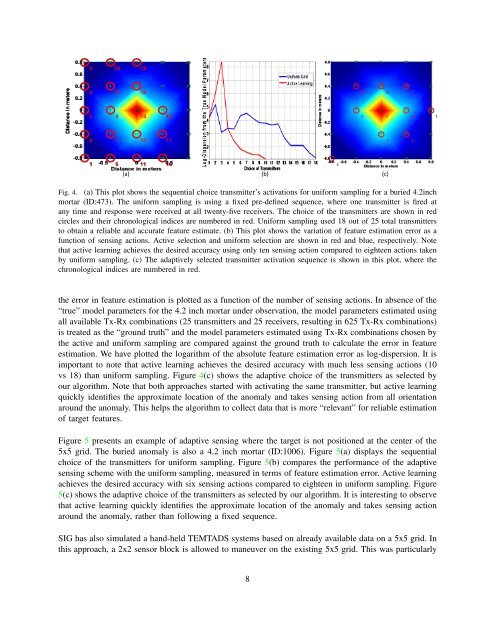INTERIM REPORT - Strategic Environmental Research and ...
INTERIM REPORT - Strategic Environmental Research and ...
INTERIM REPORT - Strategic Environmental Research and ...
You also want an ePaper? Increase the reach of your titles
YUMPU automatically turns print PDFs into web optimized ePapers that Google loves.
(a) (b) (c)<br />
Fig. 4. (a) This plot shows the sequential choice transmitter’s activations for uniform sampling for a buried 4.2inch<br />
mortar (ID:473). The uniform sampling is using a fixed pre-defined sequence, where one transmitter is fired at<br />
any time <strong>and</strong> response were received at all twenty-five receivers. The choice of the transmitters are shown in red<br />
circles <strong>and</strong> their chronological indices are numbered in red. Uniform sampling used 18 out of 25 total transmitters<br />
to obtain a reliable <strong>and</strong> accurate feature estimate. (b) This plot shows the variation of feature estimation error as a<br />
function of sensing actions. Active selection <strong>and</strong> uniform selection are shown in red <strong>and</strong> blue, respectively. Note<br />
that active learning achieves the desired accuracy using only ten sensing action compared to eighteen actions taken<br />
by uniform sampling. (c) The adaptively selected transmitter activation sequence is shown in this plot, where the<br />
chronological indices are numbered in red.<br />
the error in feature estimation is plotted as a function of the number of sensing actions. In absence of the<br />
“true” model parameters for the 4.2 inch mortar under observation, the model parameters estimated using<br />
all available Tx-Rx combinations (25 transmitters <strong>and</strong> 25 receivers, resulting in 625 Tx-Rx combinations)<br />
is treated as the “ground truth” <strong>and</strong> the model parameters estimated using Tx-Rx combinations chosen by<br />
the active <strong>and</strong> uniform sampling are compared against the ground truth to calculate the error in feature<br />
estimation. We have plotted the logarithm of the absolute feature estimation error as log-dispersion. It is<br />
important to note that active learning achieves the desired accuracy with much less sensing actions (10<br />
vs 18) than uniform sampling. Figure 4(c) shows the adaptive choice of the transmitters as selected by<br />
our algorithm. Note that both approaches started with activating the same transmitter, but active learning<br />
quickly identifies the approximate location of the anomaly <strong>and</strong> takes sensing action from all orientation<br />
around the anomaly. This helps the algorithm to collect data that is more “relevant” for reliable estimation<br />
of target features.<br />
Figure 5 presents an example of adaptive sensing where the target is not positioned at the center of the<br />
5x5 grid. The buried anomaly is also a 4.2 inch mortar (ID:1006). Figure 5(a) displays the sequential<br />
choice of the transmitters for uniform sampling. Figure 5(b) compares the performance of the adaptive<br />
sensing scheme with the uniform sampling, measured in terms of feature estimation error. Active learning<br />
achieves the desired accuracy with six sensing actions compared to eighteen in uniform sampling. Figure<br />
5(c) shows the adaptive choice of the transmitters as selected by our algorithm. It is interesting to observe<br />
that active learning quickly identifies the approximate location of the anomaly <strong>and</strong> takes sensing action<br />
around the anomaly, rather than following a fixed sequence.<br />
SIG has also simulated a h<strong>and</strong>-held TEMTADS systems based on already available data on a 5x5 grid. In<br />
this approach, a 2x2 sensor block is allowed to maneuver on the existing 5x5 grid. This was particularly<br />
8

















